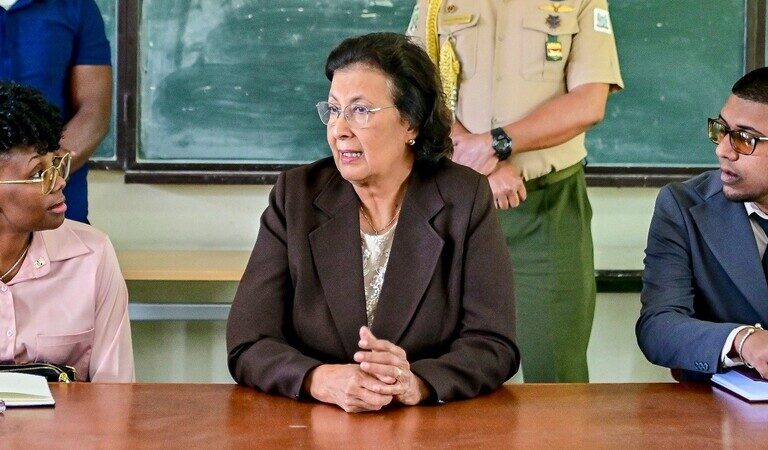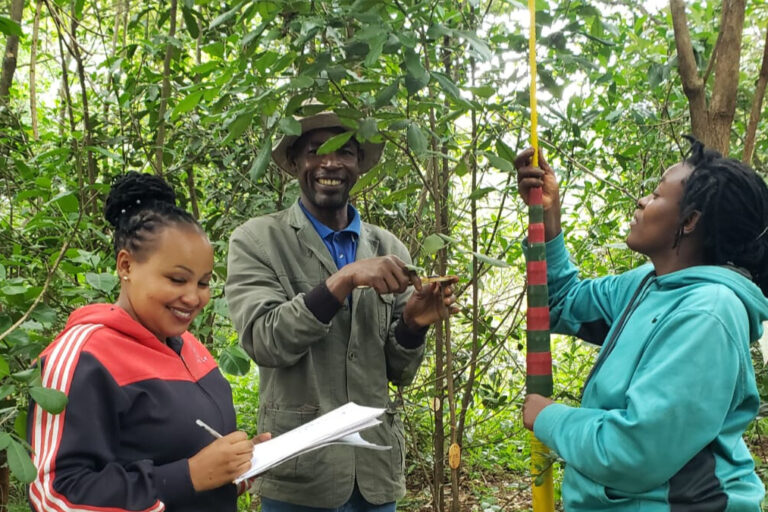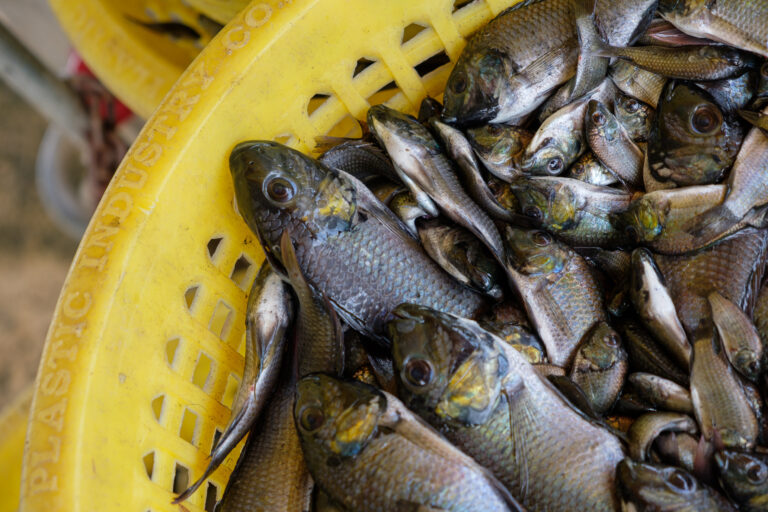- Beginning in 2019, devastating floods on the shores of Kenya’s Lake Victoria have inundated homes, displaced families and left some orphaned children in charge of caring for their siblings and running the household.
- Many families continue to live in makeshift camps, hoping to rebuild and renew their lives; the effects of the flooding have been particularly harsh on children who have had to drop out of school or work to ensure the family’s survival.
- Experts attribute the floods to a combination of factors, including climate change, increased rainfall and lack of vegetation to control runoff; in 2015, an international research team predicted swiftly rising waters that could harm the region.
- UNICEF reports a concerning increase in the number of children affected by flooding in recent years, as climate change leads to more crises that can disrupt education, destabilize families and leave long-term effects on child development and psychosocial well-being.
On a fateful day in 2019 that is etched into the memories of local residents, the tranquility along Kenya’s Lake Victoria shores was shattered by an overwhelming surge of water. The unsuspecting communities were caught off guard, forced to flee for their lives, desperately grasping onto whatever belongings they could salvage.
In the chaos and confusion, many children witnessed a landscape they had known their entire lives succumb to a force beyond their understanding. Amid the mounting panic, they were forced to make choices that no child should have to make — swim through unfamiliar currents or cling to fragments of their once-beloved possessions that now floated away.
Fate had already cast some of the children into orphanhood. Others would later lose their ailing parents and grandparents in makeshift camps that were built to shelter those who had lost their homes during the floods.
Many residents of these makeshift camps have experienced sanitation-related illnesses, including persistent coughs, malaria and diarrheal diseases. Boniface Otieno, a local chief of the area known as Kanyagwal, says he suspects some of the recorded deaths may have been linked to rising malaria cases.
After the floods, 12 once-thriving villages lay submerged, leaving many children adrift in a sea of uncertainty. Mongabay visits Nyamasao camp in Ombaka, in the Nyando sub-county of Kisumu, some 300 kilometers (185 miles) northwest of Nairobi where the events of 2019 remain vivid.
Left with nothing but the clothes on their backs, these children — who are the heads of their own households, in many cases caring for younger siblings — find themselves stranded and grappling with the harsh realities of their new existence.
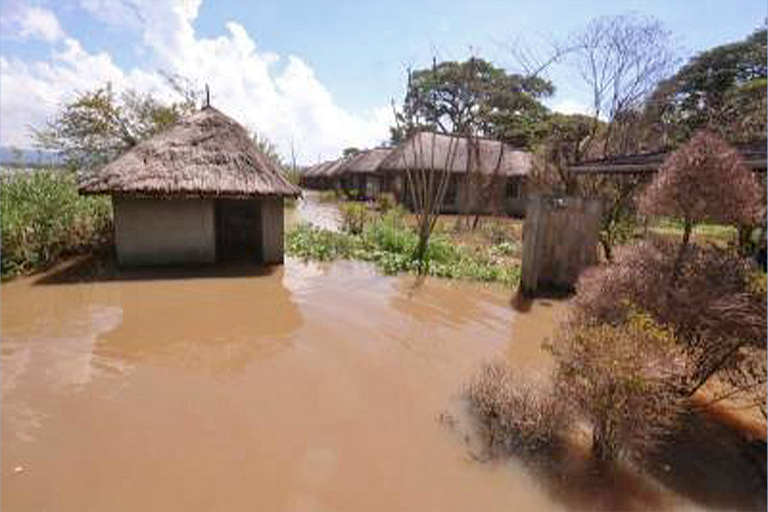
Shelters, overwhelmed by the sudden influx of displaced families, provide minimal relief, offering little more than a temporary respite. Access to clean water, food and medical care becomes a daily struggle, exacerbating the already dire circumstances they face.
“I saw our house disappear before my eyes,” recounts 13-year-old Sharon Akinyi in Ombaka village, her voice trembling with a mix of fear and sorrow. She heads a family of three siblings. “We lived in a crowded tent for a while, but now we are back in a temporary mud house built by our neighbors. But what hurts the most is not being able to go to school anymore,” she says.
“I had dreams of becoming a teacher, but the floods took everything away from us. I had no choice but to drop out of school and take care of my younger siblings, the youngest being 2 years old. It breaks my heart to see them suffer, but I have to be strong for them.
“To feed my siblings, I have to take on manual work that I never thought I would have to do. I work long hours doing odd jobs, carrying heavy loads, and sometimes even begging for food. It’s exhausting, but I do it because I have to provide for my family.”
The number of people, including children, displaced by floods in Kenya has seen a significant rise in recent times, according to Hellen Cheruto, the regional manager of Kenya Red Cross.
A 2021 report by the Kenyan government and the United Nations Development Programme (UNDP) reveals that more than 37,140 families have been displaced by floods along the shores of Lake Victoria, which have been steadily rising since 2019.
Wangui Karanja, UNICEF field office chief for Kenya, draws attention to the devastating impact these floods have on children. Data from the local government’s Children Services Department indicate that approximately 3,420 children in the area are currently living in makeshift camps, with 12 households headed by children. Some are trying to rebuild their homes with the help of other villagers.

Foreseeing a future of changing waters
Lake Victoria, once a source of life and sustenance for hundreds of communities, has wreaked havoc on the lives of those who call its shores home. As the waters continue to rise due to changing climate patterns and other factors, families are forced to abandon their houses, leaving behind a trail of despair and broken dreams.
Thanks to an upsurge in rainfall brought about by changing climate patterns, the Lake Victoria Basin has witnessed a surge in both the frequency and intensity of rainfall events. This deluge of precipitation, coupled with a lack of natural vegetation to absorb and slow down the runoff, contribute to lake water rise.
In addition, clearing of trees and vegetation in the lake’s catchment area is eroding the natural capacity to regulate water flow. With fewer trees to act as buffers, the region is experiencing increased runoff, resulting in an influx of rainwater directly into Lake Victoria.
In March 2015, an international team of researchers warned that water levels in Lake Victoria were rising fast. But the research that emerged from that initiative, the HydroClimate Project for Lake Victoria (HyVic), remained largely unnoticed by locals until five years later when families awoke to find the lake inside their homes.
Local scientists observed that the lake was advancing into the land around it by up to 10 meters (33 feet) per day. That was despite clear skies and no rain in the region for weeks.
According to the research, the villagers experienced a backflow, in which the balance between the lake’s outflow and inflow had been tipped due to changing climate patterns — a phenomenon not just on the lake, but in other regions worldwide as well.
“The result is that the lake starts discharging excess water into the land around it. In doing so, it is eroding shorelines, altering ecosystems and causing flooding and economic damage,” says Raphael Kapiyo, an environmental scientist and a professor at Maseno University in Kenya.
North Carolina University professor Fredrick Semazzi, who led the HyVic team, was quoted in the Kenyan paper The Standard, saying that after a period of decreased rainfall, the situation would reverse and Lake Victoria would swiftly replenish its waters, leading to an abrupt rise in water levels.
Semazzi warned that this surge would lead to property destruction and that the rising waters would hit climate-sensitive infrastructure, power generation, roads, construction sites and businesses near the lake.
On July 16, 2016, a year after scientists had warned about Victoria’s advance, the then-executive director of Nile Basin Initiative, John Rao Nyaoro, was quoted in Uganda’s Observer cautioning that the lake’s water levels were growing unstable.
Nyaoro blamed it on climate change.
At the time, many residents on the shores of Lake Victoria either ignored these predictions or dismissed them as global warming propaganda. (Over the years, many Kenyans have been exposed to various climate-related information, leading some to question the legitimacy of these messages, often dismissing them as propaganda.)
Seven years later, hundreds of families are still living in makeshift camps as their homes have become fragile, uninhabitable islands.

Families suffer dual disasters
Among the most vulnerable victims of these floodings are the families now headed by children, who bear the brunt of the disaster’s impact. Many of their families were displaced during the peak of the COVID-19 pandemic in Kenya, and humanitarian organizations played a crucial role in supporting the affected villagers to cope with the dual shocks.
Cheruto of the Red Cross states that the 2019 flood was the worst the area has experienced since the 1960s. And rising waters continue to push people out, to this day.
“The flooding can be attributed to multiple factors, including climate change, urbanization and farming,” Cheruto explains. “The dikes were unable to contain the flood due to the backflow of the lake, leading to this unprecedented disaster.”
The impact on human settlements and livelihoods has been devastating, as highlighted by the UNDP report. It reveals the destruction of farmlands, grazing lands and critical infrastructure such as buildings, roads, electricity and bridges. The situation remains dire, with current data from the Red Cross indicating that 15 villages now remain submerged, leaving 966 families residing in makeshift camps.
Responding to the ongoing emergency, the Red Cross has tripled its provision of humanitarian assistance, including hygiene and sanitation facilities, as well as psychosocial support.
Cheuto emphasizes, “The Red Cross remains committed to extending humanitarian assistance to those displaced. We earnestly look to both local and national governments to step up and allocate land for those who continue to reside in the camps for a permanent stay.”

In 2020, the organization provided aid to approximately 17,000 households, a stark increase compared with previous years in which they assisted a maximum of 3,000 households.
“We witnessed a surge in the number of flood-related incidents,” Cheruto states, “prompting us to mobilize additional resources to address the threefold increase in demands from flood victims.”
Recognizing the vulnerability of certain groups, such as individuals with special needs, the Red Cross workers have provided shelter and mobility devices. These groups are often the most neglected by climate action efforts and are particularly susceptible to the impacts of climate crises. The organization is also considering cash transfers for this vulnerable population instead of traditional food and non-food provisions.
Cheruto emphasizes the toll this work takes on the limited Red Cross staff, who often face stress and depression due to the distressing scenes they encounter. To alleviate some of the burden, the organization relies on community volunteers to support their efforts.
“These families are in desperate need of humanitarian assistance. Although we face constraints in providing food and non-food items, we do our best to assist them,” Cheruto states.
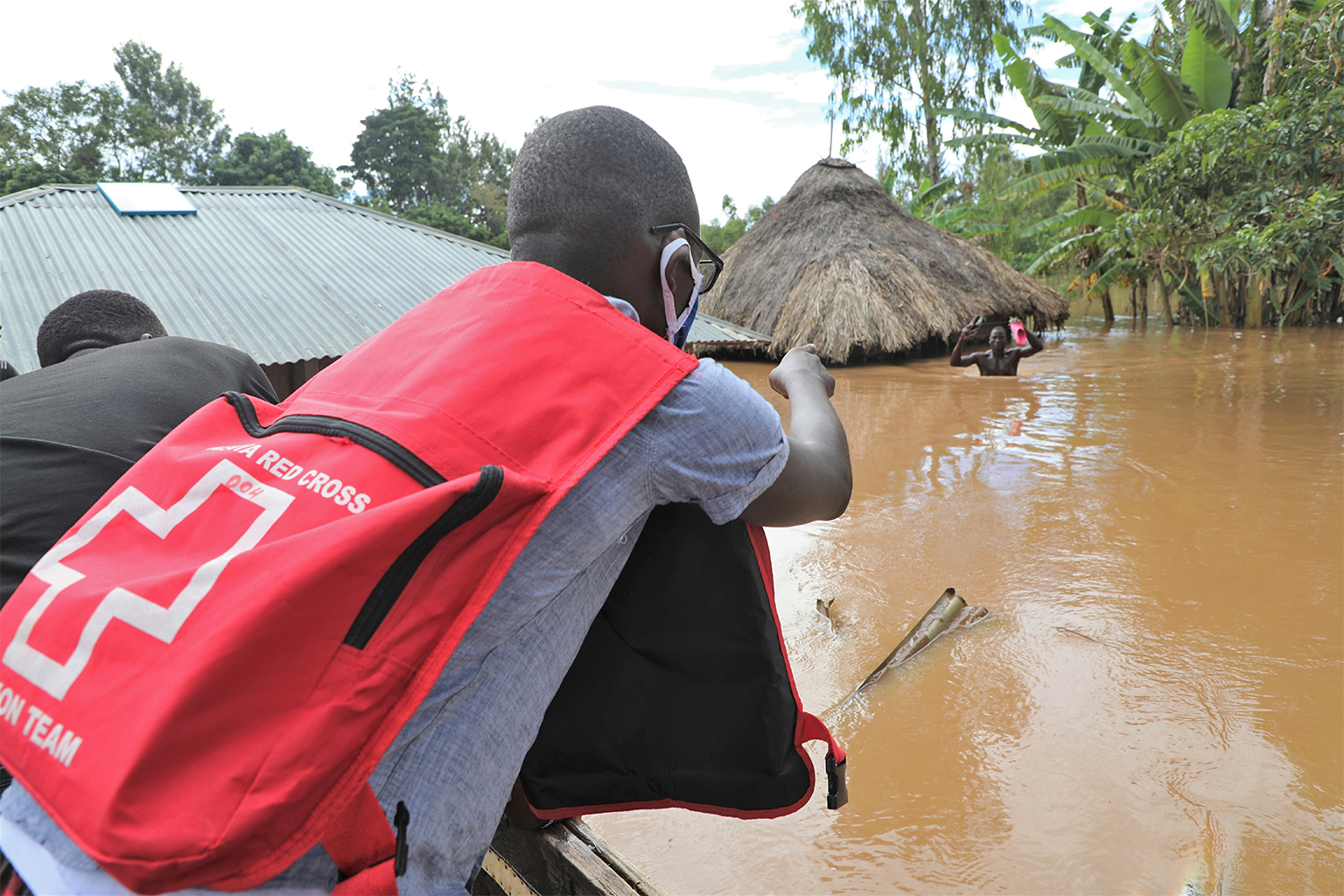
Children forced to take charge
Wangui of UNICEF says the floodwaters that rise with alarming frequency sweep away not only homes — but also the stability of families, leaving behind a vacuum that children, thrust into leadership roles, struggle to fill.
“These children require a level of care and support that goes beyond the ordinary,” Wangui explains. “The absence of adult guardians has profound implications for their emotional well-being, education and overall development. They need access to psychological counseling, educational opportunities and safe environments that foster their growth.”
In the neighborhood Mongabay visits, we meet three siblings who find themselves thrust into adulthood far too soon, orphaned at the tender ages of 8, 10 and 12. For five years, Naomi Akello, the elder, has shouldered the weight of responsibility, navigating the complexities of life with strength and determination.
“My father passed away in 2018,” Naomi shares, her voice shaken from her experiences. “We were left with our ailing mother, who couldn’t hold on after the floods. She passed away in the makeshift camp in early 2020.”
“One morning, my mother was shivering,” she continues, her memories vivid. “I tried to give her water, but she wasn’t drinking. When our neighbors arrived at the camp, they found my mother still, unmoving. That’s when they told us she had passed away.”
At just 12 years old, she acts as the anchor of the household. Cooking meager meals over an open fire, the family scrapes together what little they have, stretching it as far as possible to feed each other.
“I do manual work to get by,” she says. “After my mother passed away and we were left on our own, I had to make ends meet. I had to drop out of school to support us.”
“We seek help from well-wishers who understand our struggle. It’s a daily battle for survival, and we rely on donations to get by.

A global problem
According to UNICEF, floods of unprecedented magnitude in 2022 left more than 27 million children at risk across 27 countries, wreaking havoc in regions from Chad to Pakistan, Yemen, Bangladesh, and beyond. The number of affected children reached its highest point in over three decades.
The impact of these floods has been most severe on the most vulnerable children, who now face a multitude of threats. Among these dangers are the risk of drowning, outbreaks of diseases, lack of access to safe drinking water, malnutrition, disrupted education and increased violence. These children find themselves in dire situations, enduring hardships far beyond what their parents experienced.
In November 2022, Paloma Escudero, the head of the UNICEF delegation for COP27, expressed grave concern over the escalating crisis. “We are seeing unprecedented levels of flooding all around the world this year, and with it, an explosion in threats to children,” she said. Escudero emphasized that the climate crisis has reached a critical point, with flooding levels not seen in generations.
Mongabay caught up with 16-year-old Chris Omondi, a student in the Lake Victoria region who is caught in a daily struggle to survive. Living in an almost dilapidated mud house that teeters on the verge of collapse, Omondi is the elder of his four siblings.

Determined to pursue his education despite the odds, Omondi’s story sheds light on the plight of many children living in camps along the lake. Walking home from school with a worn-out backpack slung over his shoulder, Omondi seems weighed down not only by his books but also by the burden of his circumstances. His eyes, filled with a mixture of determination and weariness, reflect the resilience that has become a part of his daily life.
“I live in constant fear that one day I will return from school to find my house washed away,” he says, his voice conveying a mixture of anxiety and hope. “But I can’t let the floods wash away my dreams.
“My parents fell victim to diseases linked to the flooding,” he says. “After the floods struck, my father fell ill with continues diarrhea and vomiting; doctors said it was because of drinking dirty water — he couldn’t recover. He passed away in 2020. Then, it was my mother’s turn. The floods had weakened her, and when we were forced to live in the makeshift camp, her health deteriorated further. She couldn’t hold on, and she left us in early 2021.
“We laid our parents to rest nearby a makeshift camp; we couldn’t bury them at our submerged home, and so we borrowed a place on a higher ground for their final resting place,” he solemnly recounts.
Officials at the Children Services Department speak of the dire situation for families headed by children like Omondi. “These children endure unimaginable hardships on a daily basis. The constant threat of displacement, the lack of basic amenities and the psychological trauma inflicted by their circumstances take a toll on their overall well-being,” says children’s officer John Wainaina. “The vulnerability of these children is alarming. They deserve our utmost attention and support.”
Mongabay observs that older children take on caregiving roles for their younger siblings, drawing on a strength far beyond their years. In their eyes, a glimmer of hope remains, refusing to be extinguished by the chaos that surrounds them.

A rising global problem
As floods continue across the globe, families headed by children are among the most marginalized groups affected by these disasters. Reports from various regions underscore the urgent need for action to safeguard the well-being and future of these young individuals.
In the African nations of Mozambique, Malawi and Zimbabwe, devastating floods displaced thousands of families in the wake of Cyclone Idai, leaving many children at the forefront of the crisis. In Latin America, countries like Colombia and Peru are also grappling with the dire consequences of flooding. And most recently in Derna, Libya, the historic flooding unleashed with the collapse of two dams has left widespread trauma for children and families who survived.
According to UNICEF, flooding has resulted in the loss of homes, schools and basic services around the world. Children who have lost their parents and caretakers face immense challenges in providing for their siblings and ensuring their safety amid the chaos.
But the impact of flooding on families headed by children extends beyond immediate displacement and loss. Access to education is severely disrupted, as schools are damaged or inaccessible. UNICEF’s data indicate that millions of children globally are deprived of their right to education due to the effects of floods. These disruptions rob children of the opportunity to break the cycle of poverty and build a brighter future for themselves and their communities.
Furthermore, the psychological toll on children cannot be underestimated. Witnessing the destruction of their homes and communities, these young individuals experience trauma and distress, with limited access to the necessary support systems. UNICEF stresses the importance of prioritizing psychosocial support to help these children cope with the emotional scars left by the floods.
In response to these urgent needs, UNICEF and partner organizations are working to provide emergency shelters, access to clean water and sanitation facilities, nutrition and health care services. Additionally, efforts are being made to establish safe spaces and provide psychosocial support to help children heal and rebuild their lives.
However, these efforts are just the beginning, experts say. As the frequency and intensity of floods continue to rise due to climate change, it is crucial for governments, humanitarian organizations and the global community to prioritize the protection and well-being of children in disaster preparedness, response and long-term recovery plans.
In the heart of Kenya’s makeshift camps, where some children run the household, weathering five long years of displacement due to floods, they have learned to support and care for each other, forging unbreakable bonds that provide solace and strength. They dream of brighter days, envisioning a future where they can rebuild their lives and community.
Banner image: People select fish on Rusinga Island, Lake Victoria, Kenya. Image by ryan harvey via Flickr (CC BY-SA 2.0).
See related coverage:
Humanitarian experts report ‘cascading crises’ as climate, health emergencies soar
Human pressures strain Lake Tanganyika’s biodiversity and water quality
Citation:
Rising Water Levels in Kenya’s Rift Valley Lakes, Turkwel Gorge Dam and Lake Victoria: A Scoping Report. (2021). Retrieved from Republic of Kenya, United Nations Development Programme website: https://ir-library.ku.ac.ke/bitstream/handle/123456789/22851/Rising%20Water%20Levels%20in%20Kenya%e2%80%99s%20Rift%20Valley%20Lakes%2c%20Turkwel%20…..pdf?sequence=1&isAllowed=y











